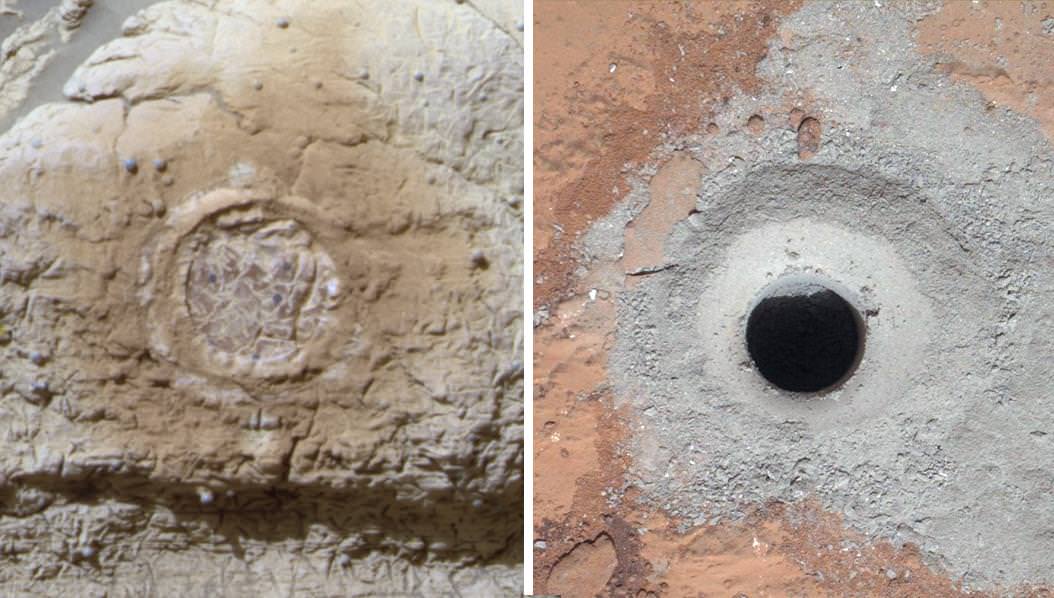After analyzing the first powder ever drilled from the interior of a Martian rock,
NASA's
Curiosity rover
discovered some of the key chemical ingredients necessary for life to have thrived on early Mars billions of years ago.
Curiosity
has achieved her goal of discovering a habitable environment on the Red Planet, mission scientists reported today at a briefing held at NASA headquarters in Washington, D.C.
Data collected by Curiosity's two analytical chemistry labs (SAM and CheMin) confirm that the gray powder collected from inside the sedimentary rock where the rover is exploring - near an ancient Martian stream bed - possesses a significant amount of
phyllosilicate clay minerals; indicating an environment where Martian microbes could once have thrived in the distant past.
"We have found a habitable environment which is so benign and supportive of life that probably if this water was around, and you had been on the planet, you would have been able to drink it," said John Grotzinger, the chief scientist for the Curiosity Mars Science Laboratory mission at the California Institute of Technology in Pasadena, Calif.
Curiosity
cored the rocky sample
from a fine-grained, sedimentary outcrop named "John Klein" inside a shallow basin named Yellowknife Bay, and
delivered pulverized powered
to the Sample Analysis at Mars (SAM) and Chemistry and Mineralogy (CheMin) instruments inside the robot.
The presence of abundant phyllosilicate clay minerals in the John Klein drill powder indicates a fresh water environment. Further evidence derives from the veiny sedimentary bedrock shot through with calcium sulfate mineral veins that form in a neutral to mildly alkaline pH environment.
[caption id="attachment_100674" align="aligncenter" width="580"]
This side-by-side comparison shows the X-ray diffraction patterns of two different samples collected from the Martian surface by NASA's Curiosity rover. These images were obtained by Curiosity's Chemistry and Mineralogy instrument (CheMin) and show the patterns obtained from a drift of windblown dust and sand called "Rocknest" (left) and from a powdered rock sample drilled by Curiosity from the "John Klein" bedrock (right). The presence of abundant phyllosilicate clay minerals in the John Klein drill powder suggest a fresh water environment. The presence of calcium sulfates suggests a neutral to mildly alkaline pH environment. NASA/JPL-Caltech/Ames[/caption]
"Clay minerals make up at least 20 percent of the composition of this sample," said David Blake, principal investigator for the CheMin instrument at NASA's Ames Research Center in Moffett Field, Calif.
The rovers 7 foot (2.1 meter) long robotic arm fed aspirin sized samples of the gray, pulverized powder into the miniaturized CheMin SAM analytical instruments on Feb. 22 and 23, or Sols 195 and 196. The samples were analyzed on Sol 200.
Scientists were able to identify carbon, hydrogen, oxygen, nitrogen, sulfur and phosphorus in the sample - all of which are essential constituents for life as we know it based on organic molecules.
"The range of chemical ingredients we have identified in the sample is impressive, and it suggests pairings such as sulfates and sulfides that indicate a possible chemical energy source for micro-organisms," said Paul Mahaffy, principal investigator of the SAM suite of instruments at NASA's Goddard Space Flight Center in Greenbelt, Md.
[caption id="attachment_100585" align="aligncenter" width="580"]
Curiosity accomplished Historic 1st drilling into Martian rock at John Klein outcrop on Feb 8, 2013 (Sol 182), shown in this context mosaic view of the Yellowknife Bay basin taken on Jan. 26 (Sol 169) where the robot is currently working. The robotic arm is pressing down on the surface at John Klein outcrop of veined hydrated minerals – dramatically back dropped with her ultimate destination; Mount Sharp. Credit: NASA/JPL-Caltech/Ken Kremer/Marco Di Lorenzo[/caption]
The discovery of phyllosilicates on the floor of Gale crater was unexpected and has delighted the scientists. Based on spectral observations from Mars orbit. Grotzinger told me previously that phyllosilicates had only been detected in the lower reaches of Mount Sharp, the 3 mile (5 km) high mountain that is Curiosity's ultimate destination.
Grotzinger said today that Curiosity will remain in the Yellowknife Bay area for several additional weeks or months to fully characterize the area. The rover will also conduct at least one more drilling campaign to try and replicate the results, check for organic molecules and search for new discoveries.
Ken Kremer
 Universe Today
Universe Today
